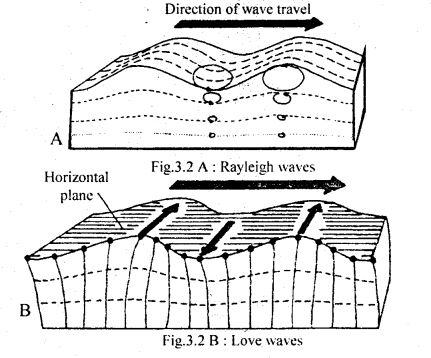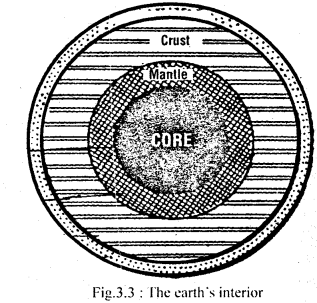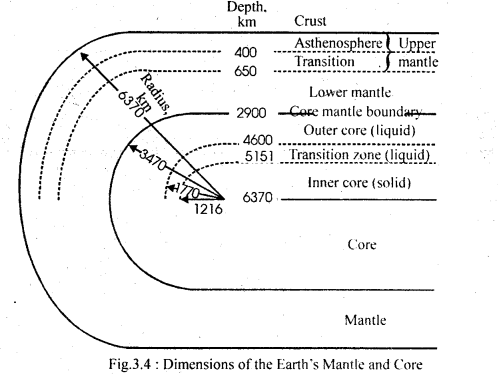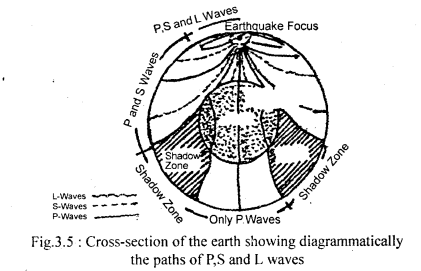Here we are providing Class 11 Geography Important Extra Questions and Answers Chapter 3 Interior of the Earth. Important Questions for Class 11 Geography are the best resource for students which helps in class 11 board exams.
Important Questions for Class 11 Geography Chapter 3 Interior of the Earth
Interior of the Earth Important Extra Questions Very Short Answer Type
Question 1.
What are Body waves?
Answer:
The earthquake waves which travel through the solid body of the earth are called Body waves.
Question 2.
Name two types of Body waves.
Answer:
‘P’ (primary) and ‘S’ (secondary) waves.
Question 3.
Where does the asthenosphere lie?
Answer:
Asthenosphere lies in the upper mantle, or below the earth’s crust.
Question 4.
What is Gutenberg discontinuity?
Answer:
A plane of the discontinuous surface between the core and the mantle is known as Gutenberg discontinuity.
Question 5.
What is the effect on ‘P’ waves at the mantle-core boundary?
Answer:
The ‘P’ waves make an abrupt drop in velocity at the mantle- core boundary.
Question 6.
What does ‘M’ discontinuity stand for?
Answer:
It stands for Mohorovicic discontinuity.
Question 7.
Which region in the earth’s interior is referred to as the low-velocity zone?
Answer:
Asthenosphere in the upper part of the mantle is referred to as the low-velocity zone.
Question 8.
Which layer in the interior of the earth consists of ‘shadow zone’?
Answer:
Shadow zone lies within the earth’s core.
Question 9.
What is Love wave?
Answer:
It is an earthquake wave that travels along the surface of the ‘ earth with a motion entirely horizontal.
Question 10.
Name the three layers of the earth.
Answer:
They are core (barysphere), mantle (mesosphere) and crust (lithosphere).
Question 11.
What is a seismograph?
Answer:
It is a sensitive instrument that records the intensity of vibrations of earthquake waves and helps in earthquake prediction.
Question 12.
Name two types of surface waves.
Answer:
- Rayleigh waves
- Love waves
Question 13.
What is the temperature of the core?
Answer:
The temperature of the core is about 2000°C.
Question 14.
What are the various sources of heat in the earth?
Answer:
- Radioactivity
- The heat of aggradation
- The temperature of materials of which the earth is made
Question 15.
What is the depth of the earth’s crust?
Answer:
0-100 km. from the surface of the earth.
Question 16.
What is the radius of the earth’s core?
Answer:
3470 km. approximately.
Question 17.
What do you mean by Sial and Sima?
Answer:
It is the uppermost layer of the earth. It consists of silica and magnesium. Its average depth is 2800 km. It has a density of 4.75.
Question 18.
Define the term Nife.
Answer:
The core of the earth is called Nife. It consists of Nickel and ferrous. It has an average depth of 3500 km. and a density of 13 g/cm3.
Question 19.
What is a caldera?
Answer:
Caldera complexes are the most explosive of earth’s volcanoes.
Question 20.
Name the basic parts of a volcano.
Answer:
Crater, caldera, vent, fumaroles are the basic parts of a volcano.
Question 21.
Name the various intrusive forms.
Answer:
Batholiths, Lacoliths, Lapoliths, Phacoliths, Sills and Dykes.
Question 22.
Define ‘Pacific ring’.
Answer:
It is the region around the Pacific ocean. There are active volcanoes all around the Pacific OceAnswer:
Question 23.
What is lithosphere?
Answer:
The crust and the uppermost part of the mantle together are called the lithosphere.
Question 24.
Name the different types of earthquakes.
Answer:
Tectonic/Volcanic, Collapse, Explosion and Reservoir induced earthquake.
Question 25.
How explosion earthquakes occurs?
Answer:
Explosion earthquakes occur due to the explosion of chemical or nuclear devices. .
Question 26.
Name the direct sources which provide information about the earth’s interior.
Answer:
Volcanic eruptions, Deep Ocean Drilling Project and mining.
Interior of the Earth Important Extra Questions Short Answer Type
Question 1.
How do the rocks of the earth’s mantle behave when subjected to the earthquake waves?
Answer:
The earth’s mantle behaves as an elastic solid when subjected to the earthquake waves. It changes the shape of the landscape when stresses are applied, but returns exactly to its original shape when these stresses are removed.
Question 2.
What is asthenosphere?
Answer:
The asthenosphere is the zone of hot rocks, believed to be in a plastic condition, underlying the solid lithosphere or the earth’s crust. It is sometimes termed as the soft layer of mantle or the low-velocity zone because the earthquake waves travel in it at reduced velocities.
Question 3.
Distinguish between Body waves and surface waves.
Answer:
The earthquake waves which travel longitudinally through the solid body of the earth are called Body waves. They move-faster. Those waves which move transversally along the surface are known as Surface waves. They move slowly and cause more disaster.
Question 4.
Define surface waves along with their sub-types.
Answer:
Hie earthquake waves which move along the free upper crust of the earth are called surface waves. Surface waves are of two types, viz, Rayleigh waves and Love waves. Rayleigh waves can be visualised as water waves travelling across the surface of a still pond after a pebble has been tossed into the water. But the motion in the Love waves is entirely horizontal, at right, angles to the direction of the wave motion. The Rayleigh and Love waves travel more or less the same length, but with different speeds.

Question 5.
Describe Mohorovicic Discontinuity.
Answer:
The surface of a sudden increase in wave velocity, which separates the crust above from the mantle below is Mohorovic or ‘Moho’ or ‘M’ discontinuity. It is named after the Yugoslavian seismologist Mohorovicic, who first detected it in 1909.
Question 6.
How is the crust distinguished from the mantle?
Answer:
The crust is distinguished from the mantle by the presence of an abrupt change in the velocity of seismic waves. This corresponds to the abrupt change in the rigidity of the rock from crust to mantle. This change in rigidity is due to the change in the mineral composition or in the physical state of rocks.
Question 7.
Write a short note on the earth’s core.
Answer:
‘Core’ means the innermost part. Earth’s core is the innermost or central part of the earth’s interior. It has a radius of approximately 3470 km (2160 miles). On the basis of the behaviour of the seismic waves, it has been proved that the earth’s outer core is in a liquid state. Earth’s magnetic field is generated here. Between the outer core and the mantle that envelops it is the Gutenberg discontinuity.
Question 8.
Describe the earth’s crust.
Answer:
Earth’s crust is the topmost layer of the earth’s interior. It is also called the lithosphere. It has an average density of 3.0 g/cm. Its thickness varies from about 7 km. beneath the oceans to 70 km. under some parts of the continents. It is separated from the mantle below by Mohorovicic Discontinuity.
Question 9.
Discuss the properties of the upper mantle.
Answer:
Based on the behaviour of seismic waves, the mantle is subdivided into two major parts – the upper mantle and the lower mantle. The upper mantle extends from the crust to a depth of about 650 km. including the asthenosphere, which occupies the upper 300 to 400 km. The upper boundary of the upper mantle is forward by Mohorovicic Discontinuity, which separates it from the overlying crust.
Question 10.
How do the rocks of the earth’s mantle behave when subjected to the earthquake waves?
Answer:
The P’ waves move faster and make an abrupt drop in velocity of the mantle-core boundary, whereas ‘S’ waves move slowly and terminate at the mantle-core boundary. Through earth’s mantle (nearly ’ 2900 km) the speed of the earthquake waves is so high that only a very rigid and dense rock will satisfy the observed condition; the rocks behave as an elastic solid so that the mantle changes its shape when shear stresses are applied and returns exactly to its former shape when stresses are removed.
Question 11.
What is the main evidence in favour of the layered structure of the earth?
Answer:
The scientists accept that the earth has a layered structure. The earth has three layers or shells :
- crust
- mantle
- core.
These layers are distinguished on the basis of their physical and chemical properties, i.e.,
- thickness,
- density,
- temperature,
- metallic contents and
- rocks.
Question 12.
What do you mean by the term ‘Barysphere’?
Answer:
The Barysphere is the central core of the earth. It has a depth of 4980 km to 6400 km. It has a density of 17 g/cm3. It consists of heavy minerals and it is also called ‘core’. The core of the earth is metallic in > nature.
Question 13.
Describe the three types of earthquake waves.
Answer:
These waves are :
- ‘P’waves or longitudinal waves-These are also known as primary waves. These travel in the direction of their movement. They can travel through solids as well as liquid and gaseous matter.
- ‘S’ waves or transverse waves – These are also known
as secondary waves. These travel at a right angle to the direction of their oscillation. They can travel in solid ‘? medium only. - ‘L’ waves – These are known as surface waves. These waves do hot go deep into the earth.
Question 14.
What do you understand by the structure of the earth?
Answer:
The earth is made up of many layers of different materials. The density and temperature of each layer vary according to the depth. The study of the layered composition of the earth is known as the structure of the earth.
Interior of the Earth Important Extra Questions Long Answer Type
Question 1.
Write short notes on :
1. Shadow zone
2. The earth’s crust
Answer:
1. Shadow zone – It lies beneath the surface of the earth, i.e., in its interior. The seismic waves bend as they travel through the core and, therefore, ‘P’ waves are not directly received in a zone known as the shadow zone. Also, ‘S’ waves are not received there because they do not travel through the liquid outer core. Only surface waves are received in the shadow zone.
2. The earth’s crust – This is also known as the lithosphere. The crust is the outermost shell 1 of the earth. It consists of the surface granite SIAL and the intermediate basic SIMA layers. It is separated from the under layer MANTLE by the Mohorovicic Discontinuity. There are two kinds of crust – continental and oceanic. Continental crust has an average density of 3 g/cnt3, the average thickness of 35 to 40 km. (22 to 25 miles) with large areas older than 1500 million years. Continental crust is a complicated structure and has a variable composition. Oceanic crust is thinner than continental crust. Its average density is 2.7 g/cm3 and average thickness of only 6 km. (3.7 miles), with the simple layered structure of the uniform composition.
Question 2.
Discuss how do seismic waves suggest layering of the earth’s interior.
Answer:
Seismic waves are the earthquake waves. The movement of seismic waves tells us a great deal about the earth’s internal structure. The shock waves arising from earthquakes pass through the interior of the earth in different ways and provide evidence about the inaccessible interior region of the earth. Seismic waves are of two types -: body waves and surface waves. Body waves travel through the solid body of the earth, whereas surface waves move along the free upper crust of the earth. Surface waves, in turn, are of two types, viz, Rayleigh waves and Love waves.
Body waves also have two sub-types, viz, ‘P’ waves and ‘S’ waves. ‘P’ (primary waves) pass through all the medium solid, liquid and gaseous, whereas ‘S’ or secondary waves do not pass through liquids.
Based on the above observation related to seismic waves, the interior has been divided into three layers – core, mantle and crust.
The core is the innermost or central layer, the crust is the outermost layer, whereas mantle lies in the middle. Since ‘S’ waves cannot pass through the central part of the earth or core, it suggests that this part is made up of a medium which is not solid. This proves that the earth’s outer core is in a liquid state in contrast to the surrounding mantle which is solid.

The ‘P’ waves make an abrupt drop in velocity at the mantle-core _ boundary, whereas ‘S’ waves terminate here. Based on the behaviour of seismic waves, the mantle is sub-divided into two major parts – the upper mantle and the lower mantle.
The crust is distinguished from the mantle by the presence of an abrupt change in velocity of seismic waves. The change in rigidity, in turn, is due to change in the universal composition or in the physical state of the rocks.
Question 3.
Describe the earth’s mantle.
Answer:
The mantle is that part of the earth’s interior which lies between the core and the crust. It consists of solid ultrabasic rocks. The mantle is about 2900 km thick with a density of about (3.0 to 3.4) g/cm3. The lower surface of the mantle forces Gutenberg Discontinuity, the uppermost layer forces the Asthenosphere.
The ‘P’ or primary earthquake waves make an abrupt drop in velocity at the mantle-core boundary, whereas ‘S’ or secondary waves terminate at this boundary. . It is because of the presence of a plane of the discontinuous surface between the core and the mantle known as Gutenberg Discontinuity.

Based on the behaviour of seismic waves, the mantle is sub-divided into two major parts – the upper mantle and the lower mantle. The upper mantle extends from the crust to a depth of about 650 km. and includes 300 to 400 km wide Asthenosphere, the uppermost part of the mantle. Rocks in Asthenosphere behave as an elastic solid. This region is referred to as the low-velocity zone.
Question 4. How do the waves of different types tell us about the changes in the nature of different layers of the earth’s interior?
Answer:
Seismic waves are the earthquake waves. The movement of seismic waves tells us a great deal about the earth’s internal structure. The shock waves arising from earthquakes pass through the interior of the earth in different ways and provide evidence about the inaccessible interior region of the earth. Seismic waves are of two types -: body waves and surface waves. Body waves travel through the solid body of the earth, whereas surface waves move along the free upper crust of the earth. Surface waves, in turn, are of two types, viz, Rayleigh waves and Love waves.
Body waves also have two sub-types, viz, ‘P’ waves and ‘S’ waves. ‘P’ (primary waves) pass through all the medium – solid, liquid and gaseous, whereas ‘S’ or secondary waves do not pass through liquids.
Based on the above observation related to seismic waves, the interior has been divided into three layers – core, mantle and crust.
The core is the innermost or central layer, the crust is the outermost layer, whereas mantle lies in the middle. Since ‘S’ waves cannot pass through the central part of the earth or core, it suggests that this part is made up of a medium which is not solid. This proves that the earth’s outer core is in a liquid state in contrast to the surrounding mantle which is solid.

The ‘P’ waves make the abrupt drop in velocity at the mantle-core boundary, whereas ‘S’ waves terminate here. Based on the behaviour of seismic waves, the mantle is sub-divided into two major parts – the upper mantle and the lower mantle.
The crust is distinguished from the mantle by the presence of an abrupt change in velocity of seismic waves. The change in rigidity, in turn, is due to change in the universal composition or in the physical state of the rocks.
The mantle is that part of the earth’s interior which lies between the core and the crust. It consists of solid ultrabasic rocks. The mantle is about 2900 km thick with a density of about (3.0 to 3.4) g/cm3. The lower surface of the mantle forces Gutenberg Discontinuity, the uppermost layer forces the Asthenosphere.
The ‘P’ or primary earthquake waves make an abrupt drop in velocity at the mantle-core boundary, whereas ‘S’ or secondary waves terminate at this boundary. . It is because of the presence of a plane of the discontinuous surface between the core and the mantle known as Gutenberg Discontinuity.

Based on the behaviour of seismic waves, the mantle is sub-divided into two major parts – the upper mantle and the lower mantle. The upper mantle extends from the crust to a depth of about 650 km. and includes 300 to 400 km wide Asthenosphere, the uppermost part of the mantle. Rocks in Asthenosphere behave as elastic solid. Th,is region is referred to as the low-velocity zone.

Question 5.
Distinguish between :
1. Body Waves and Surface Waves
2. The crust of the earth and Core of the earth
3. Gutenberg Discontinuity and Mohorovicic Discontinuity
Answer:
1. Body waves and Surface Waves :
Seismic waves are the earthquake waves. The movement of seismic waves tells us a great deal about the earth’s internal structure. The shock waves arising from earthquakes pass through the interior of the earth in different ways and provide evidence about the inaccessible interior region of the earth. Seismic waves are of two types -: body waves and surface waves. Body waves travel through the solid body of the earth, whereas surface waves move along the free upper crust of the earth. Surface waves, in turn, are of two types, viz, Rayleigh waves and Love waves.
Body waves also have two sub-types, viz, ‘P’ waves and ‘S’ waves. ‘P’ (primary waves) pass through all the medium – solid, liquid and gaseous, whereas ‘S’ or secondary waves do not pass through liquids.
Based on the above observation related to seismic waves, the interior has been divided into three layers – core, mantle and crust.
The core is the innermost or central layer, the crust is the outermost layer, whereas mantle lies in the middle. Since ‘S’ waves cannot pass through the central part of the earth or core, it suggests that this part is made up of a medium which is not solid. This proves that the earth’s outer core is in a liquid state in contrast to the surrounding mantle which is solid.

The ‘P’ waves make an abrupt drop in velocity at the mantle-core boundary, whereas ‘S’ waves terminate here. Based on the behaviour of seismic waves, the mantle is sub-divided into two major parts – the upper mantle and the lower mantle.
The crust is distinguished from the mantle by the presence of an abrupt change in velocity of seismic waves. The change in rigidity, in turn, is due to change in the universal composition or in the physical state of the rocks.
2. Crust of the earth and Core of the earth:
| The crust of the Earth | The core of the Earth |
| l. This is the outermost layer of the earth. | 1. This is the innermost layer of
of the earth. |
| 2. The average density is 2.73g/cm3. | 2. The average density is I7.2g/cm3. |
| 3. It covers about 0.5% part of the earth. | 3. It covers about 83% part of the
the earth. |
| 4. It is made up of silica and
aluminium. |
4. It is made up of nickel and ferrous. |
3. Gutenberg Discontinuity and Mohorovicic Discontinuity:
| Gutenberg Discontinuity | Mohorovicic Discontinuity |
| 1. It is the boundary between the mantle and the core. | 1. It is the boundary between the crust arid the mantle. |
| 2. It was observed by Beno Gutenberg in 1926. | 2. It was observed by a Yugoslavian seismologist Mohorovicic in 1909. |
| 3. The ‘P’ waves make an abrupt drop in the velocity at the mantle-core boundary, while S-waves disappear here. | 3. The surface of a sudden increase in wave velocity, which separates crust above from the mantle below is Mohorovicic discontinuity. |
| 4. This making a place at the dis-continuous surface between the core and mantle is known as Gutenberg discontinuity. |